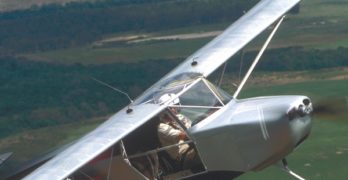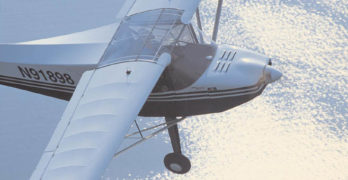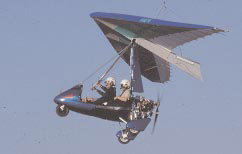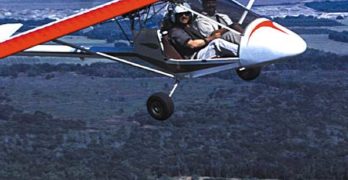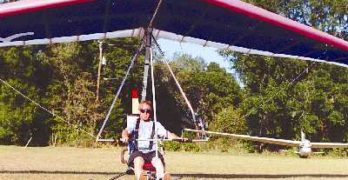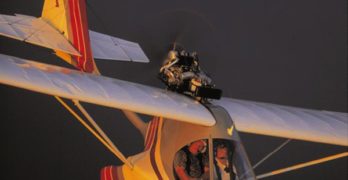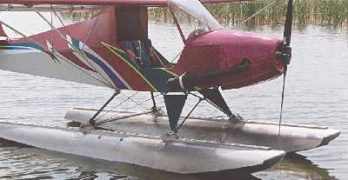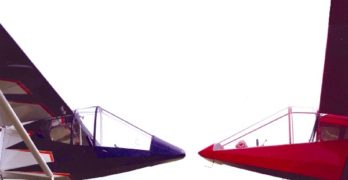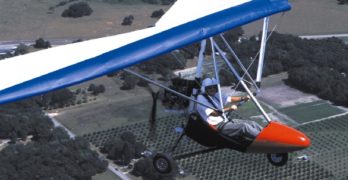Editor’s Notes: The following article is reprinted from the April 1981 issue of Ultralight, the original title of the current Experimenter magazine. I recently came across this article while reviewing EAA’s early ultralight publications searching for other historical information and felt it gives us a great understanding of the “mood” surrounding the development of FAR Part 103 … and that, perhaps, it parallels today’s situation as we anticipate a sport pilot/light-sport aircraft rule. Charlie Schuck, EAA’s Washington representative, who recently retired, wrote the article. It’s also interesting to note that this article was written in April of 1981 … and the notice of proposed rulemaking that eventual became FAR Part 103 was not published until the summer of 1982. Hmmm! … Mary
Why a Notice of Proposed Rule Making (NPRM) for Ultralights
We all would agree that no federal regulations concerning ultralights would be a utopian situation. However, when we are sharing the airspace with other flying vehicles, there needs to be some coordinated effort, or chaos will soon take over.
Search Results for : Ultralight April
Not finding exactly what you expected? Try our advanced search option.
Select a manufacturer to go straight to all our content about that manufacturer.
Select an aircraft model to go straight to all our content about that model.
An Escapade Just for You
Engineering design is usually an evolutionary process. While occasionally a breakthrough idea comes to market, most development in aviation is a result of small steps. The Escapade is a good example.
Once Flying K Enterprises (now Sky Raider LLC) offered their Sky Raider. The single-seater had much in common with the immensely popular SkyStar Aircraft Kitfox. In fact, when SkyStar offered their Kitfox Lite single-seater, Flying K built the welded fuselage for them.
Then came the Sky Raider II with a tight back seat that could be used for an occasional ride though not instruction as no controls were installed in the rear. The new Summit offered by Just Aircraft late last year was a variation on the Sky Raider II theme.
Company leadership changes as do their designs and the path from Flying K to Just Aircraft is convoluted; other business names are involved. By example, Rocky Mountain Wings, run by former Flying K partner Stace Schrader, offers their very similar Ridge Runner.
Rans S-6S Coyote II
As the dawn of the sport pilot rule changes approaches,
Kansas-based RANS Inc. is one of the
most successful kit aircraft manufacturers in the
light aviation industry.
Randy Schlitter, RANS’ boss and founder, is now a seasoned
veteran of the kit airplane business. Over his
years in business, he has created several popular aircraft
designs that have found favor in the United
States, Europe, and about 50 other countries around
the globe.
Of the broad RANS line, the one model that has most revved up
buyers is the S-6S Coyote II. Despite competition from hundreds of
other aircraft, the Coyote line has sold an impressive fleet of 1,500 aircraft. The single-place version, S-4/5, first
flew 20 years ago and has also sold reasonably
well, but it is the Coyote II that
has become the single most successful
RANS design.
The two-place Coyote II is available in
two models—the S6-S and the S-6ES.
Light Sport Aircraft – What you may fly!
The FAA’s new sport pilot/light-sport aircraft notice of proposed rulemaking (NPRM) has been released. With a 90- day comment period underway, the proposed pilot certificate and aircraft categories are on the minds of all light-aircraft producers and anyone who flies for fun. The flying machines that will fit under the proposed new aircraft categories will be called light-sport aircraft, and in this article we’ll take a look at what’s currently available|and what the future may hold.
“The FAA’s new rule is destined to globalize the light aviation industry.”
The promise is great for Americans. When the new sport pilot/light-sport aircraft NPRM changes are finalized and implemented, we will enter a new era in light aviation. People who have wanted a light aircraft to fly for fun but who didn’t have the time or skill to build it will be able to buy a ready-to-fly airplane. And, they’ll be able to learn to fly in less time and at less expense than the cost of acquiring a private pilot certificate.
New Kolb Aircraft
Sometimes I’m amazed that we’ve now got ultralight pilots buying engines that cost more than $10,000. Twenty years ago, Eipper Formance (Quicksilver) sold complete ultralights that cost $3,499. Even in the ’90s, many complete ultralights – engine and all – cost less than the price of a Rotax 912 4-stroke engine on its own. One that meets that description is Kolb Aircraft’s Mark III with a 50-hp Rotax 503 dual carb 2-cycle engine.
Nonetheless, the 81-hp Rotax 912 has invaded the realm of what is loosely called “ultralight” flying. Of course, a Rotax 912-powered aircraft simply cannot be used on a single-place Part 103 ultralight. And any 2-place plane with a 912 is less likely to qualify as an ultralight trainer under the training exemption to FAR Part 103; the big engine may push the plane too fast and could make it heavier than 496 pounds (the ultralight trainer empty weight limit).
Sky Cycle
In a world of ultralights populated with powered parachutes, powered paragliders, weight-shift trikes, and all manner of 3-axis ultralights, why not a powered hang glider? Why not return to our roots?
For those too new to the scene to remember, ultralights started out as powered hang gliders. John Moody, the man widely known as the “Father of Ultralights,” first motorized and flew a hang glider called the Icarus II (which evolved into the Easy Riser). Moody’s first ultralight, back in the mid-1970s, had no landing gear and no tail because those appendages weren’t on hang gliders then, or now.
After Moody’s early work – plus that of others in the hang gliding and ultralight community – other pioneers began adding power packages to more conventional hang gliders. The Easy Riser Moody flew had good performance but didn’t break down as efficiently as the fully-foldable “flex wings,” as they are commonly known today.
Interplane Skyboy
In May 2000 I wrote about the imported Sabre Aircraft Venture trike. That model from the Ukraine was quite impressive and worthy of your consideration. Now from the Czech Republic comes the Interplane Skyboy. Should Yankee ultralight manufacturers show concern? Yes, I’d say so. However, American pilots – while perhaps showing an interest in imported designs – don’t seem to buy a lot of these planes. Or do they?
In recent years we’ve seen trike sales soar. Few industry leaders predicted this despite the persistent efforts of the big European trike builders. Many veterans claimed trikes would never have an impact on the majority of pilots who prefer 3-axis controls. They are being proved wrong, for now anyway.
A key reason that holds back U.S. purchases of imported aircraft has to do with local support. Even a good importer can’t always control when spare parts are available. Interplane solves this dilemma in an interesting way and with American style: they bought the Czech Republic factory.
Flying Sky Raider
Since Flying K Enterprises’ Sky Raider arrived on the scene 4 years ago, the ultralight design has achieved excellent success in the market selling more than 140 kits (not including the 65 or so fuselages shipped to SkyStar Aircraft which they use for their Kitfox Lite). However, the company behind the Sky Raider design has suffered in nontechnical ways.
Original Flying K principals brothers Ken and Stace Schraeder split up and started separate companies making ultralights. Then, only months after the split, Ken Schraeder was killed while flying a Sky Raider (see “Flightlines – Kenny Schraeder Killed in Crash,” April ’00 Ultralight Flying! magazine).
Despite these setbacks, the Sky Raider flies onward. In fact, Flying K Enterprises seems to be healthy and energetic despite the twin losses.
When the company shows their Sky Raider floatplane model and an example of their coming 2-seater, crowds often flock around the ultralights. I was full of anticipation to see how the floatplane would fly.
New Kolbra ULT
For ultralight enthusiasts, the focus of this pilot report is on the Kolbra model that I flew in late summer 2000, fitted with the 66-hp Rotax 582. A King Kolbra version is also available, but because it is equipped with the 80-hp 4-stroke, 4-cylinder Jabiru engine, it cannot make FAR Part 103 trainer exemption weight limits.
The two new Kolbra offerings give The New Kolb Aircraft Company a better footing in the 2-seat market. Until now, of the five models New Kolb offered for sale, the Mark III was their only 2-seater. Another 2-seater, the low-wing Laser, never made it to market and the outlook appears uncertain for any introduction of that model.
The New Kolb Aircraft Company is clearly focused on 2-seaters. The company released a new version of their popular Mark III, named the Mark III Xtra, in the spring of 2000 and now the Kolbras. Their single-seaters – the FireFly, FireStar, FireStar II (with optional jump seat but no dual controls), and SlingShot – remain unchanged… and that’s a very good thing in my opinion.
Maverick
All right, what is this? A trike with no upper support? What does the designer think he’s doing, trying to be some kind of maverick? Well, yeah!
Kamron Blevins runs the show at North Wing Design. When I first met him, I’d call him a mere lad, except that makes me sound old. So, Kamron was a “young entrepreneur” from the Seattle area who made hang glider sails for a living. (His mom probably thought this sounded like as odd an occupation as you think it does.)
Funny thing, though. The kid grew up, got good at making wings, branched into trike wings, and now manufactures entire trikes. And you know what? It’s a darn good trike with some excellent thinking. Let’s look it over.
Youth Gains Experience
Blevins isn’t a kid anymore. But he looks around and sees all his old hang gliding buddies looking older, too. Some of them are using wheels on their gliders (as a backup safety feature for those not-so-perfect foot-landings).


